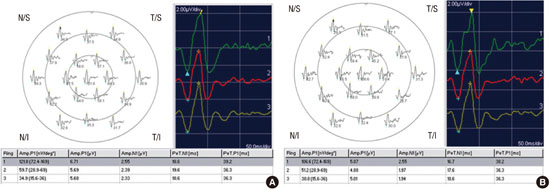1. Hindmarch I, Kerr JS, Sherwood N. The effects of alcohol and other drugs on psychomotor performance and cognitive function. Alcohol Alcohol. 1991; 26:71–79.
2. Leonard KE, Blane HT. Psychological Theories of Drinking and Alcoholism. 2nd ed. New York, NY: The Guilford Press;1999.
3. Azcona O, Barbanoj MJ, Torrent J, Jané F. Evaluation of the central effects of alcohol and caffeine interaction. Br J Clin Pharmacol. 1995; 40:393–400.
4. Reed TE. Effect in vivo of a sub-hypnotic dose of ethanol on nerve conduction velocity in mice. Life Sci. 1979; 25:1507–1512.
5. Valenzuela CF. Alcohol and neurotransmitter interactions. Alcohol Health Res World. 1997; 21:144–148.
6. Gessa GL, Muntoni F, Collu M, Vargiu L, Mereu G. Low doses of ethanol activate dopaminergic neurons in the ventral tegmental area. Brain Res. 1985; 348:201–203.
7. Odom JV, Bach M, Brigell M, Holder GE, McCulloch DL, Tormene AP. Vaegan. ISCEV standard for clinical visual evoked potentials (2009 update). Doc Ophthalmol. 2010; 120:111–119.
8. Hood DC, Bach M, Brigell M, Keating D, Kondo M, Lyons JS, Marmor MF, McCulloch DL, Palmowski-Wolfe AM; International Society For Clinical Electrophysiology of Vision. ISCEV standard for clinical multifocal electroretinography (mfERG) (2011 edition). Doc Ophthalmol. 2012; 124:1–13.
9. Hood DC, Greenstein V, Frishman L, Holopigian K, Viswanathan S, Seiple W, Ahmed J, Robson JG. Identifying inner retinal contributions to the human multifocal ERG. Vision Res. 1999; 39:2285–2291.
10. Colrain IM, Taylor J, McLean S, Buttery R, Wise G, Montgomery I. Dose dependent effects of alcohol on visual evoked potentials. Psychopharmacology (Berl). 1993; 112:383–388.
11. Ikeda H. Effects of ethyl alcohol on the evoked potential of the human eye. Vision Res. 1963; 3:155–169.
12. Knave B, Persson HE, Nilsson SE. A comparative study on the effects of barbiturate and ethyl alcohol on retinal functions with special reference to the C-wave of the electroretinogram and the standing potential of the sheep eye. Acta Ophthalmol (Copenh). 1974; 52:254–259.
13. Rohrbaugh JW, Stapleton JM, Parasuraman R, Zubovic EA, Frowein HW, Varner JL, Adinoff B, Lane EA, Eckardt MJ, Linnoila M. Dose-related effects of ethanol on visual sustained attention and event-related potentials. Alcohol. 1987; 4:293–300.
14. Skoog KO. The c-wave of the human D.C. registered ERG. III. Effects of ethyl alcohol on the c-wave. Acta Ophthalmol (Copenh). 1974; 52:913–923.
15. Chan HL, Siu AW. Effect of optical defocus on multifocal ERG responses. Clin Exp Optom. 2003; 86:317–322.
16. Tabuchi H, Yokoyama T, Shimogawara M, Shiraki K, Nagasaka E, Miki T. Study of the visual evoked magnetic field with the m-sequence technique. Invest Ophthalmol Vis Sci. 2002; 43:2045–2054.
17. Tobimatsu S. Transient and steady-state VEPs—reappraisal. Int Congr Ser. 2002; 1232:207–211.
18. Weiner JL, Zhang L, Carlen PL. Potentiation of GABAA-mediated synaptic current by ethanol in hippocampal CA1 neurons: possible role of protein kinase C. J Pharmacol Exp Ther. 1994; 268:1388–1395.
19. Sepúlveda MR, Mata AM. The interaction of ethanol with reconstituted synaptosomal plasma membrane Ca2+-ATPase. Biochim Biophys Acta. 2004; 1665:75–80.
20. Crooks J, Kolb H. Localization of GABA, glycine, glutamate and tyrosine hydroxylase in the human retina. J Comp Neurol. 1992; 315:287–302.
21. Pan ZH, Lipton SA. Multiple GABA receptor subtypes mediate inhibition of calcium influx at rat retinal bipolar cell terminals. J Neurosci. 1995; 15:2668–2679.
22. Naarendorp F, Sieving PA. The scotopic threshold response of the cat ERG is suppressed selectively by GABA and glycine. Vision Res. 1991; 31:1–15.
23. Holder GE. Pattern electroretinography (PERG) and an integrated approach to visual pathway diagnosis. Prog Retin Eye Res. 2001; 20:531–561.
24. Klemp K, Larsen M, Sander B, Vaag A, Brockhoff PB, Lund-Andersen H. Effect of short-term hyperglycemia on multifocal electroretinogram in diabetic patients without retinopathy. Invest Ophthalmol Vis Sci. 2004; 45:3812–3819.
25. Gundogan FC, Erdurman C, Durukan AH, Sobaci G, Bayraktar MZ. Acute effects of cigarette smoking on multifocal electroretinogram. Clin Experiment Ophthalmol. 2007; 35:32–37.
26. Tyrberg M, Ponjavic V, Lövestam-Adrian M. Multifocal electroretinogram (mfERG) in patients with diabetes mellitus and an enlarged foveal avascular zone (FAZ). Doc Ophthalmol. 2008; 117:185–189.
27. Moon CH, Park TK, Ohn YH. Association between multifocal electroretinograms, optical coherence tomography and central visual sensitivity in advanced retinitis pigmentosa. Doc Ophthalmol. 2012; 125:113–122.
28. Bergholz R, Rüther K, Schroeter J, von Sonnleithner C, Salchow DJ. Influence of chloroquine intake on the multifocal electroretinogram in patients with and without maculopathy. Doc Ophthalmol. 2015; 130:211–219.
29. Mezey E, Holt PR. The inhibitory effect of ethanol on retinol oxidation by human liver and cattle retina. Exp Mol Pathol. 1971; 15:148–156.
30. Oshima S, Haseba T, Masuda C, Kakimi E, Sami M, Kanda T, Ohno Y. Individual differences in blood alcohol concentrations after moderate drinking are mainly regulated by gastric emptying rate together with ethanol distribution volume. Food Nutr Sci. 2012; 3:732–737.
31. Arden GB, Wolf JE. The human electro-oculogram: interaction of light and alcohol. Invest Ophthalmol Vis Sci. 2000; 41:2722–2729.









 PDF
PDF ePub
ePub Citation
Citation Print
Print




 XML Download
XML Download